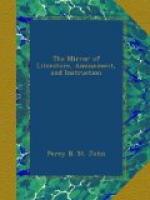“Where
the full-voiced choir
Lie, with their hallelujahs, quench’d
like fire.”
In 1791, by the removal of some fragments of ruin in the chapter-house, the sepulchres of several of the abbots were discovered; but the inscriptions were obliterated. Over the chapter-house were the library and scriptorium. The architecture or Fountains Abbey is mixed; in some parts are seen the sharp-pointed windows, in others the circular arches. The great eastern window is indescribably magnificent, being 23 feet in width. There has been a central tower, which has long since fallen to decay. The sanctum sanctorum is 131 feet in length; over one of its eastern windows is the figure of an angel holding a scroll, dated 1283. The total length of the church is 358 feet. On the north side of the quadrangular court is the refectory, which was supported by large pillars, and adjoining it is the reading gallery, where portions of the Scriptures were delivered to the monks whilst at their meals; by the side of it are the kitchen and scullery, the former remarkable for its spacious arched fire place. Over the refectory was the dormitory, which contained 40 cells; and under the crumbling steps leading to it is the porter’s lodge. Near to the refectory are the remains of the abbot’s chambers.
But adieu to the waning glory of Fountains Abbey and the receding towers of Ripon Minster, while retracing my path of yesterday morning. I must linger awhile on the Roman way, where antiquity maintains her supremacy in spite of the war of time, and where the earth looks immutable. Now the groves of Newby Park re-appear with their “sylvan majesty,” creating unutterable sympathies; for the wind that bows the surrounding branches moves me to weep for that romantic spirit whose ashes moulder on the shores of India, where
“When the sun’s noon-glory
crests the wave,
He shines, without a shadow on his grave.”
* * H.
[2] Here Henry Percy, the
fourth Earl of Northumberland, was
murdered
by an infuriated mob, in the fourth year of Henry
VII.;
he having, as lord lieutenant of the county, levied
a
tax
on the people by order of his sovereign, for carrying
on
the
war in Bretague. Skelton, poet-laureat to Henry
VIII.
lamented
his death in some elegiac lines.
[3] Aldburgh, or Aldborough,
so called by the Normans, was the
Iseur
of the Ancient Britons, and the Isurium of the Romans.
Perhaps
there is not another Roman city, not even excepting
York,
where so many antiquities have been discovered.
The
opening
of ancient baths, burial vaults, &c. has led to
the
finding of tesselated pavements, coins, urns, rings,
lachrymatories,
seals, monumental inscriptions, medals,
statues,
chains, sacrificing vessels, &c. It is to be lamented
that
modern ignorance and barbarity are fast obliterating




